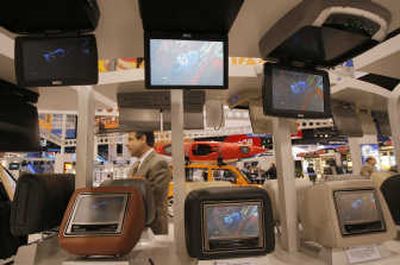At CES, a gadget for every driver

LAS VEGAS – The deep bass sound vibrates your breastbone as you meander through a corner of the massive International Consumer Electronics Show. Someone is showing off car audio systems, but it feels like the vehicles themselves are announcing their beefy presence.
And why not? Cars and automotive technologies from startups and established aftermarket makers are abundant at this gadget show. They’re coming in such variety that they encapsulate many of the advances seen elsewhere at CES in cell phones, TVs, video games and wireless Internet networking.
For example, one theme at CES is the development of touch-screen and voice-activated controls for portable devices. Cars are showing that off with systems that let people make phone calls, navigate, choose music and have e-mails read to them without having to fumble for manual controls.
Or look how CES overall is highlighting the widening availability of Internet content. Autonet Mobile Inc. offers a small box for car trunks that takes a cellular broadband signal and uses Wi-Fi to relay it to portable computers in the car, so people can browse the Internet in the vehicle. And while the car is parked near a home wireless network, people can beam music and video content to it for upcoming road trips.
“The car is a lifestyle product,” said Sterling Pratz, Autonet Mobile’s CEO. “It’s not just a car anymore.”
Other highlights Tuesday at the CES:
HDTVs adding options
HDTV manufacturers are trying to make the task of buying an HDTV set much more difficult than just choosing between LCD and plasma, 42 inches or 46 inches.
To stand out amid fierce competition, they’re adding exotic features, and even a little bit of color to the plain black bezels that have been de rigueur. They’re also chasing each other to zero – zero thickness, that is. Apparently, you can’t be too thin if you’re a TV.
All the major Asian brands revealed new sets at CES. Most of the innovation comes from the prestigious names, like Sony, Pioneer, Panasonic and Toshiba, which are trying to keep HDTVs from becoming a commodity product. If one 42-inch LCD is the same as another, the buyer is going to be looking mostly at price, and that kills the manufacturer’s margins.
Pioneer Corp. demonstrated a prototype plasma TV with a thickness of just three-eighths of an inch, claiming it is the thinnest 50-inch set ever.
Hitachi Ltd. is showing off an LCD display that is three-fourths of an inch. That’s also a prototype, but the company is bringing LCDs that are 1.5 inches thick to the U.S. market in the second quarter after launching them in Japan in December.
Radio may get captions
A new technology unveiled Tuesday would show what’s being said on the radio using a receiver with a screen that would scroll text much like closed captions roll by on TV.
No manufacturer has committed to bring the technology to market. It is backed by National Public Radio and Harris Corp., a major supplier of broadcasting equipment, as well as a new research center at Towson University near Baltimore.
Mike Starling, NPR’s chief technology officer, said the group hoped to bring in commercial broadcasters, radio manufacturers and other industry players.
Starling said he hoped text-based broadcasts would become a new standard in radio, just as digital broadcasting – known as HD Radio – did several years ago.
The text service will rely on HD Radio technology, which allows broadcasters to split their signal into multiple transmissions. Some stations use the extra capacity to broadcast additional music or talk radio channels, which can be heard on HD Radio receivers.
GPS driving past origins
They can plumb the Internet for the latest movie times, news headlines, stock figures and gas prices. They’ll even help you skirt traffic, find a parking spot or make a phone call. Oh, and they’ll navigate for you, too.
The latest global positioning system devices on display at the CES are roving information portals – well beyond the first turn-by-turn GPS guides with maps and directions.
Now practically taken for granted, GPS technology is available for tracking hikers, boaters and pilots, and it’s routine in cars, sports watches and cell phones. As a result, plain vanilla portable navigation devices have plunged below $200, forcing manufacturers to fight for ways to continue commanding premium prices. Their response: to cram as many extra features on the devices as possible.
At CES, Garmin Ltd. announced the Nuvi 880, which makes its debut in the second quarter for $1,000, and the 780, out next month for $800. Both get real-time information from Microsoft Corp.’s MSN Direct system, which requires a subscription of $50 a year or $130 for the life of the device. The more expensive model has speech-recognition so drivers can bark their commands.
As useful as the Microsoft system is, it provides one-way communication only, from the Internet to the device. Other new navigation units are harnessing cellular networks to let users send information back upstream.
The upcoming Dash Express GPS device will let users conduct Web searches for locations or products, movie times, or the cheapest gas – and then it will direct them to the destination.
Magellan Navigation Inc., which is partnering with Google Inc. to provide local business listings on a $1,300 car-navigation unit, expects to eventually let users send contacts and calendars to their devices.